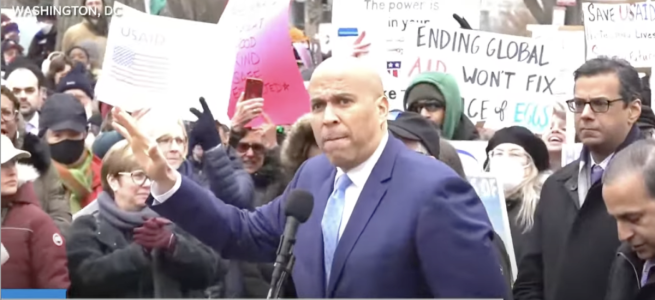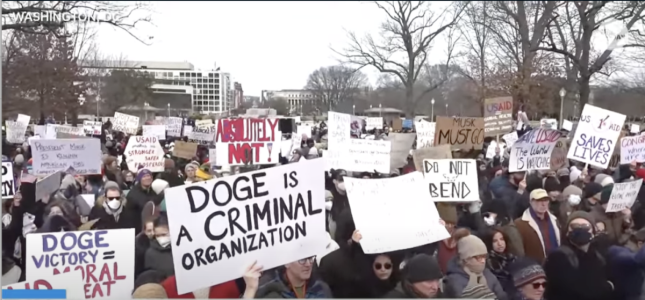Outrage in the streets: This in-depth look at protests against Trump policies explain why
- Replies 3
From the bustling streets of Philadelphia to the icy steps of Michigan's state Capitol, a wave of discontent is sweeping across the United States.
Citizens from every corner of the nation are standing up, their voices united in a chorus of protest against the early actions of the Trump administration.
Let’s take you beyond the headlines and into the heart of this American outcry, examining why thousands are taking to the streets and what it means for our democracy. Do you agree or disagree with their pleas?
Many demonstrations have occurred in various cities in the US on Wednesday to protest the early actions of the Trump administration.
The Trump administration's policies on immigration, transgender rights, and a controversial proposal regarding Palestinians in the Gaza Strip have ignited a firestorm of activism.
In cities like Philadelphia and state capitols in California, Michigan, Minnesota, Texas, Wisconsin, Indiana, and more, protesters braved the elements to make their stand.
Signs waved in the air, some denouncing President Donald Trump, others targeting billionaire Elon Musk and his leadership of the newly formed Department of Government Efficiency (DOGE), and still others decrying Project 2025—a blueprint for a hard-right shift in American government and society.

Margaret Wilmeth, a protester in Columbus, encapsulated the sentiment of many when she said, “I’m appalled by democracy’s changes in the last, well, specifically two weeks — but it started a long time ago. So I’m just trying to put a presence into resistance.”
The protests are the output of the power of digital organization. Online platforms have become the modern town square, where hashtags like #buildtheresistance and #50501 (symbolizing 50 protests in 50 states in one day) serve as rallying cries.
Social media accounts and websites have been instrumental in issuing calls to action, with messages urging citizens to “reject fascism” and “defend our democracy.”
One of the focal points of the protests is the involvement of Elon Musk and the DOGE. In Lansing, Catie Miglietti expressed her alarm at Musk's access to Treasury Department data, a concern echoed by many who fear for the integrity of sensitive information like Social Security details.
“If we don’t stop it and get Congress to do something, it’s an attack on democracy,” Miglietti said.
“DOGE is not legit,” stated one poster on the state Capitol steps in Jefferson City, Missouri, where dozens of protesters banned together. “Why does Elon have your Social Security info???”
Despite assurances from a Treasury Department official that a technology executive working with DOGE will have “read-only access,” the unease persists.
Members of Congress have also shared their concern regarding DOGE’s involvement with the US government payment system, worrying it may lead to security risks or missed payments for programs like Social Security and Medicare.
Also read: A review: Executive Orders issued by Donald Trump in his first week

President Trump's flurry of executive orders has touched on trade, immigration, and climate change, among other issues. These actions have galvanized the opposition, with Democrats and activists alike raising their voices.
In cities like Austin, Atlanta, Sacramento, and Denver, protesters have made their presence felt, with some demonstrations coinciding with Immigration and Customs Enforcement operations, adding to the tension.
“We need to show strength,” advised Laura Wilde, a former public school occupational therapist in Austin. “I think we’re in a state of shock.”
In St. Paul, Minnesota, Hallie Parten carried a sign supporting Democratic leaders, driven by “fear for what is going to happen to our country if we don’t all just do something about it.”
In Des Moines, Iowa, protesters clashed with a conservative parental rights group, while in Alabama, hundreds rallied against actions targeting LGBTQ+ people, challenging the president's power to define gender and identity.
Source: CNN-News18 / Youtube.
On Tuesday, Alabama Governor Kay Ivey swore to sign legislation echoing Trump’s recent executive order for the federal government to define sex only as male or female.
“The president thinks he has a lot of power,” the Rev. Julie Conrady, a Unitarian Universalist minister, said to the people. “He does not have the power to determine your gender. He does not have the power to define your identity.”
Also read: Lawsuit challenges US Treasury over DOGE access—is your personal data at risk?

What are your thoughts on the protests and Trump’s recent policies? Share your insights in the comments below, but please remember to remain respectful.
Citizens from every corner of the nation are standing up, their voices united in a chorus of protest against the early actions of the Trump administration.
Let’s take you beyond the headlines and into the heart of this American outcry, examining why thousands are taking to the streets and what it means for our democracy. Do you agree or disagree with their pleas?
Many demonstrations have occurred in various cities in the US on Wednesday to protest the early actions of the Trump administration.
The Trump administration's policies on immigration, transgender rights, and a controversial proposal regarding Palestinians in the Gaza Strip have ignited a firestorm of activism.
In cities like Philadelphia and state capitols in California, Michigan, Minnesota, Texas, Wisconsin, Indiana, and more, protesters braved the elements to make their stand.
Signs waved in the air, some denouncing President Donald Trump, others targeting billionaire Elon Musk and his leadership of the newly formed Department of Government Efficiency (DOGE), and still others decrying Project 2025—a blueprint for a hard-right shift in American government and society.

Demonstrators in cities across the US protested against a range of Trump administration policies. Image source: USA TODAY / Youtube.
Margaret Wilmeth, a protester in Columbus, encapsulated the sentiment of many when she said, “I’m appalled by democracy’s changes in the last, well, specifically two weeks — but it started a long time ago. So I’m just trying to put a presence into resistance.”
The protests are the output of the power of digital organization. Online platforms have become the modern town square, where hashtags like #buildtheresistance and #50501 (symbolizing 50 protests in 50 states in one day) serve as rallying cries.
Social media accounts and websites have been instrumental in issuing calls to action, with messages urging citizens to “reject fascism” and “defend our democracy.”
One of the focal points of the protests is the involvement of Elon Musk and the DOGE. In Lansing, Catie Miglietti expressed her alarm at Musk's access to Treasury Department data, a concern echoed by many who fear for the integrity of sensitive information like Social Security details.
“If we don’t stop it and get Congress to do something, it’s an attack on democracy,” Miglietti said.
“DOGE is not legit,” stated one poster on the state Capitol steps in Jefferson City, Missouri, where dozens of protesters banned together. “Why does Elon have your Social Security info???”
Despite assurances from a Treasury Department official that a technology executive working with DOGE will have “read-only access,” the unease persists.
Members of Congress have also shared their concern regarding DOGE’s involvement with the US government payment system, worrying it may lead to security risks or missed payments for programs like Social Security and Medicare.
Also read: A review: Executive Orders issued by Donald Trump in his first week

The protests were organized under the hashtags #buildtheresistance and #50501, representing 50 protests in 50 states all in one day. Image source: USA TODAY / Youtube.
President Trump's flurry of executive orders has touched on trade, immigration, and climate change, among other issues. These actions have galvanized the opposition, with Democrats and activists alike raising their voices.
In cities like Austin, Atlanta, Sacramento, and Denver, protesters have made their presence felt, with some demonstrations coinciding with Immigration and Customs Enforcement operations, adding to the tension.
“We need to show strength,” advised Laura Wilde, a former public school occupational therapist in Austin. “I think we’re in a state of shock.”
In St. Paul, Minnesota, Hallie Parten carried a sign supporting Democratic leaders, driven by “fear for what is going to happen to our country if we don’t all just do something about it.”
In Des Moines, Iowa, protesters clashed with a conservative parental rights group, while in Alabama, hundreds rallied against actions targeting LGBTQ+ people, challenging the president's power to define gender and identity.
Source: CNN-News18 / Youtube.
On Tuesday, Alabama Governor Kay Ivey swore to sign legislation echoing Trump’s recent executive order for the federal government to define sex only as male or female.
“The president thinks he has a lot of power,” the Rev. Julie Conrady, a Unitarian Universalist minister, said to the people. “He does not have the power to determine your gender. He does not have the power to define your identity.”
Also read: Lawsuit challenges US Treasury over DOGE access—is your personal data at risk?
Key Takeaways
- Demonstrators in cities across the US protested against a range of Trump administration policies, including his immigration measures, rollback of transgender rights, and a proposal regarding Palestinians in the Gaza Strip.
- The protests were organized under the hashtags #buildtheresistance and #50501, representing 50 protests in 50 states all in one day, with demonstrators using social media to coordinate.
- Critics expressed concern about Elon Musk's involvement with the Department of Government Efficiency, fearing potential security risks and access to sensitive data.
- Despite the nationwide demonstrations and concerns raised by both protesters and some members of Congress, the Trump administration continued to sign executive orders on various issues including trade, climate change, and immigration policy.
What are your thoughts on the protests and Trump’s recent policies? Share your insights in the comments below, but please remember to remain respectful.
Last edited:






